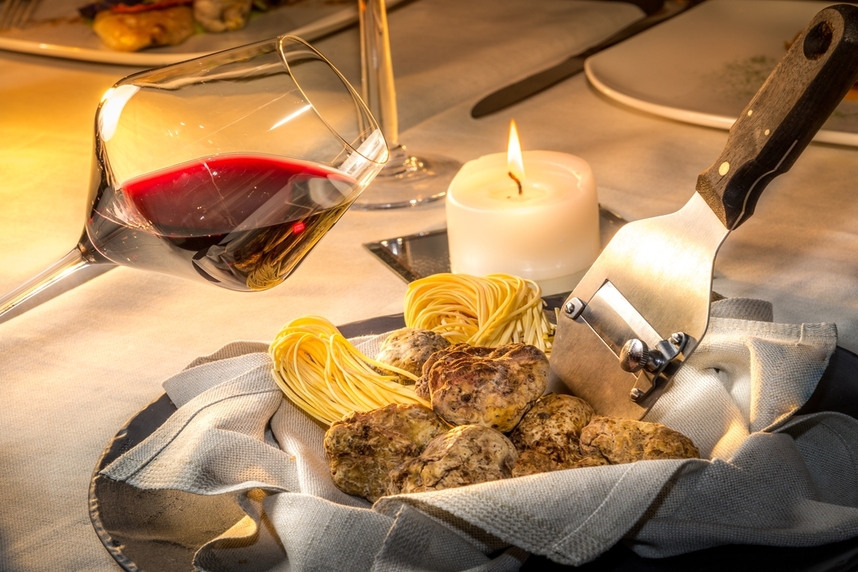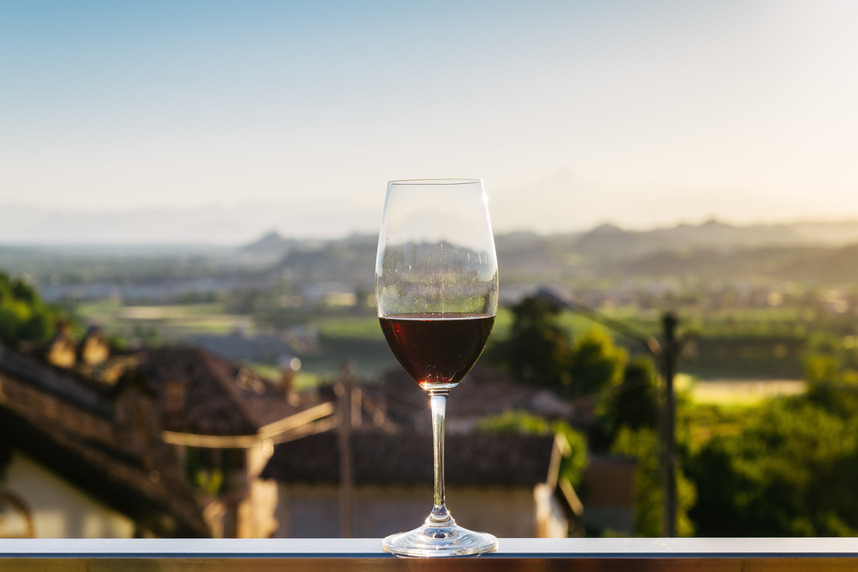With its diversified territory, which takes shape among Alpine heights, hills, plains and fascinating villages, Piedmont is a real jewel from an oenological point of view, the result of a multifaceted terroir and an ancient history. It is in this magical land - between the Langhe, Monferrato, Roero and other production areas - that some of the are produced world's most appreciated reds.
Want to know more? Here is an overview of the best Piedmontese red wines, including appellations, grape varieties and food pairings!
Grape varieties, appellations and tasting proposals
Those who approach first time Piedmontese red wines for the are immediately struck by their intensity and complexity, characteristics that are further refined with ageing. These wines, authentic expressions of an extraordinary territory, stand out for their structure, elegance and great versatility in gastronomic pairings.
Among the region's most representative grape varieties are Nebbiolo, Barbera and Dolcetto, the protagonists of some of the most prestigious appellations. Barolo DOCG and Barbaresco DOCG, both made from pure Nebbiolo grapes, offer complex aromatic profiles and extraordinary longevity. Barbera d'Asti DOCG, on the other hand, is an intense and enveloping red, perfect for accompanying richly flavoured dishes. For those seeking a softer, fruitier wine, Dolcetto Piemonte DOC is an excellent choice, ideal for enhancing first courses and meat dishes.
Discover the best expressions of these great Piedmontese red wines and let yourself be guided on a tasteful journey through the region's excellent wines!
Barolo DOCG
'Wine of kings, king of wines', defined King Charles Albert of Savoy, when he had the pleasure of tasting the Barolo wine brought as a gift by the Marquise Giulia Colbert Falletti di Barolo.
What won him over was the decisive structure, the full-bodied taste and the maturity of the organoleptic notes of this wine, not only one of the best wines of the Langhe (where the vine has been cultivated for about 2500 years), but also one of the best known and most appreciated Italian red wines.
Would you like to savour the characteristics of this excellent Piedmontese red made from grapesNebbiolo ? You can do so throughout the meal by uncorking a bottle of Barolo DOCG, whose aromatic identity is amplified by the years of ageing. Characterised by an colour intense red and elegant garnet reflections, this wine will win you over with its aromas of morello cherry and vanilla, and with a robust, balsamic sip.
Try it with elegant hors d'oeuvres based on seasoned and tasty , such as Castelmagno, Raschera or Bra, or you can pair it with cheesesfirst and second courses with enveloping flavours, such as tagliolini with truffle, risotto with Barolo, braised beef, wild boar stew or lasagna with hare ragout.
Barbaresco DOCG

Also produced from grapes Nebbiolo used in purity, Barbaresco originates in the hills near the village of the same name in the Langhe, and has done so for many centuries, although its production was mainly enhanced in the 19th century by the entrepreneur Domizio Cavazza.
The first thing that strikes one when approaching this wine is probably the name, which is said to derive from Barbarica silva, which is how the current production area was called.
The name also seems to suggest the robust and gritty soul of this wine, well represented by a bottle of Barbaresco DOCG. Its delicate colour, mottled with orange hues, almost seems to suggest a suave sensory identity, when in fact the nose comes up against a penetrating profile, with hints of morello cherry, vanilla and spices. Equally energetic is the taste, with a long, lively but balanced finish, ideal for holding its own with dishes enriched with truffles or red meat and game. Excellent to uncork with tasty truffle ravioli, risottos, tagliatelle or mature cheeses flavoured with this prized tuber, or with a mixed boiled, braised or various roasts.
Barbera D'Asti DOCG
There are those who refer to this wine in the masculine and those in the feminine, but on one thing they all agree: Barbera - especially in the denomination Asti DOCG - is synonymous with history, value, quality and grit. The vine of the same name has been cultivated in the area Monferrato since Roman times, but was only mentioned in written form in the 13th century. Thanks to its robustness, it was planted after the devastation of phylloxera, and today occupies around 30% of the entire vineyard area in the region.
In a glass of Barbera d'Asti DOCG you can perceive this vigour at first hand, which is expressed in every organoleptic trait. You can see it in the colour deep red with violet reflections, but also in the intense blackberry notes, with woody and balsamic hints. You then find it in the taste, full-bodied and carefully balanced between acidity and softness.
Pairings with Piedmontese red wines like this one - powerful and elegant - can only be as strong. You can serve it on the table with a rich board of cold cuts, national or regional, such as truffle salami, Salame Piemonte or Mocetta. In addition to typical dishes, meat it is also particularly at home alongside soups soupsand savoury , making it an ideal wine for winter or gloomy days.
(H3) Nebbiolo Langhe DOC
Nebbiolo is a wine that originates from a variety cultivated in northern Italy since Roman times, later perfected by oenologist Louis Oudart and the initiatives of Camillo Benso di Cavour. Some say it is so called because of the opaque patina that typically covers its grapes, while other hypotheses attribute the etymology to the fact that the grapes ripen in October, at a time often characterised by fog.
You may have already appreciated the characteristics of the vine in a glass of Barbaresco or Barolo, but this variety also gives life in purity to wine the Nebbiolo Langhe DOC. Excellent as a wine to store in one's cellar and to let age for a few years, it is characterised colour by an intense red with auburn highlights, and by bright and complex aromas of cherry and violet, with tones spicy conferred by ageing in wood. The taste is full and robust, fruity and with full tannins.
The advice for a perfect pairing is to offer it during a rich tastingcheese cheeses cheeses, from mature to blue , even better if goat cheese.
Dolcetto Piemonte DOC
This review of concludes Piedmont's best wines with Dolcetto, a wine that probably owes its name to the sweetness and low acidity of the grapes of the same name, rather than to its sugar content.
Although its origins are disputed between Liguria and Piedmont, it is in the latter region that it has found its favourite land, today cultivated and vinified between the provinces of Asti, Cuneo and Alessandria, in the Langhe.
Dolcetto Piemonte DOC presents itself in the glass with a colour ruby red with elegant violet reflections, while the nose displays a floral bouquet with deep vinous notes. On the palate it is harmonious, enveloping with and a very restrained acidity. important tannins
Despite its name, Dolcetto does not go well with tarts, pastries and soft cakes, but it offers great pairings with many savoury recipes, from lasagne with meat sauce to meat ravioli, from risotto with sausage to most meat dishes. It is also extraordinary with a dish of tripe or snails Piedmontese style dressed with tomato and butter.
A brief history of Piedmontese wines
We have to go back several steps (as far as the 7th century B.C.) to witness the birth of viticulture in Piedmont, attributed to the Celtic peoples. However, it was the Romans who imported new vines and providentially improved winemaking techniques, while . Benedictine monks in the Middle Ages made the activity flourish
The spread of the Barolo vine in the 18th century was decisive for local oenology, as the appreciation of the nobility (including King Carlo Alberto of Savoy) gave lustre to Piedmontese wines, encouraging research and initiatives on how to improve production, in which also participated.Camillo Benso Count of Cavour
Having overcome the devastation caused by phylloxera, Piedmont has recovered mainly thanks to Barolo and Barbaresco, which have spread their names abroad as well, thanks to the awarding of no less than 19 DOCGs and 41 DOCs.
Now that you know the red wines of Piedmont, you just have to choose your favourite labels. Where? On the catalogue Giordano Wines !
 Free Delivery from 69£
Free Delivery from 69£
